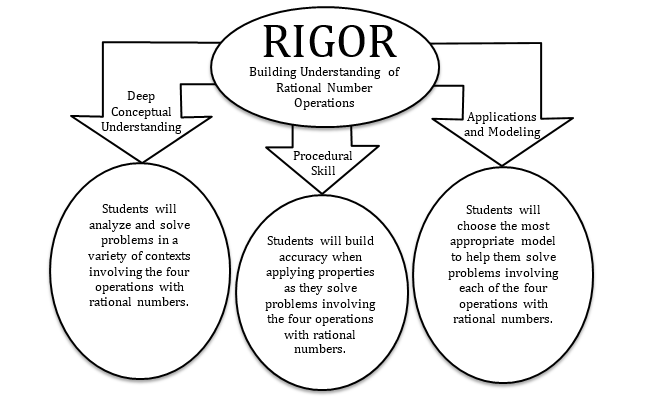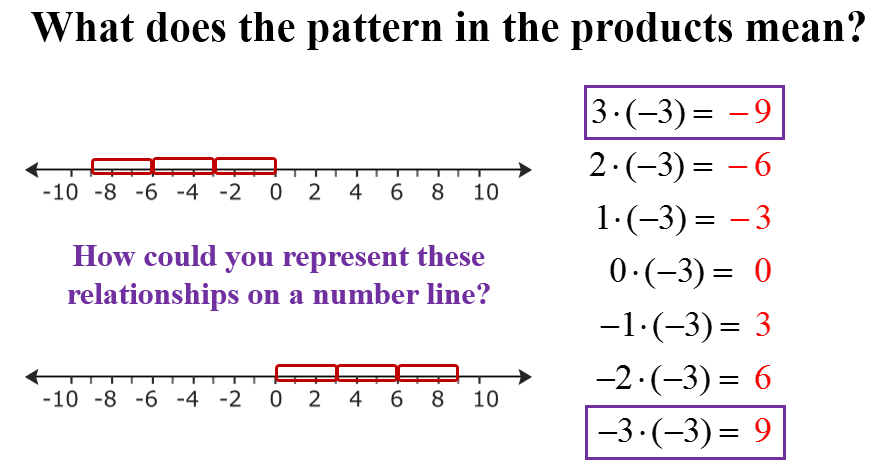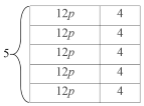Building Understanding of Rational Number Operations
Students will be able to...
- Apply and extend previous understandings of addition and subtraction to add and subtract rational numbers; represent addition and subtraction on a horizontal or vertical number line diagram
- Apply and extend previous understandings of multiplication and division of fractions to multiply and divide rational numbers.
- Solve real-world and mathematical problems involving the four operations with rational numbers.
- Apply properties of operations to calculate with numbers in any form; convert between forms as appropriate; and assess the reasonableness of answers using mental computation and estimation strategies.
*Instructional videos in the hyperlinks above are meant to support C2.0 content, but may use vocabulary or strategies not emphasized by MCPS.
The Common Core State Standards require a balance of three fundamental components that result in rigorous mathematics acquisition: deep conceptual understanding, procedural skill, and mathematical applications and modeling.

In school, your child will…
-
Apply and
extend previous understandings of addition and subtraction to add and subtract
rational numbers; represent addition and subtraction on a horizontal or
vertical number line diagram.


- Apply and extend previous understandings of multiplication and division of fractions to multiply and divide rational numbers.

- Solve real-world and mathematical problems involving the four operations with rational numbers.
- Jackie left home on Saturday and hiked 3.25 miles north, kayaked 5.5 miles south, and then biked 1.75 miles north. How many miles from home is she now?
- Apply properties of operations to calculate with numbers in any form; convert between forms as appropriate; and assess the reasonableness of answers using mental computation and estimation strategies.

At home, your child can…
- Determine the amount of money in a checking account given a series of withdrawals and deposits.
- Determine the final price of a group of item after applying a given discount and sales
- Follow a stock for a week and model the gains/losses on a number line. Determine the net value of the stock from the first day until the end of the week.
Additional Resources
Multiply positive and negative integers using the distributive property (video tutorial)
- Multiply a negative by a negative using the distributive property (video tutorial)
- Solve real-world and mathematical problems involving the four operations withrational numbers. (video tutorials)
- FeedingNumbers (game)
- Number Line Bounce(game)
- Circle 0 (game)
- BrainRacer: Integers (game)
- Grade7 Standards Unit 2 Topic 1 Building Understanding of Rational Number Operations (flexbook)
*Additional Practice links support C2.0 content, but may use vocabulary or strategies not emphasized by MCPS.
Integrating Rational Number Operations in Expressions & Equations
Students will be able to...
Apply properties of operations as strategies to add, subtract, factor, and expand linear expressions with rational coefficients.
- Understand that rewriting an expression in different forms in a problem context can shed light on the problem and how the quantities in it are related.
- Solve multi-step real-life and mathematical problems posed with positive and negative rational numbers in any form, using tools strategically. Apply properties of operations to calculate with numbers in any form; convert between forms as appropriate; and assess the reasonableness of answers using mental computation and estimation strategies.
- Use variables to represent quantities in a real-world or mathematical problem, and construct simple equations and inequalities to solve problems by reasoning about the quantities.
*Instructional videos in the hyperlinks above are meant to support C2.0 content, but may use vocabulary or strategies not emphasized by MCPS.
The Common Core State Standards require a balance of three fundamental components that result in rigorous mathematics acquisition: deep conceptual understanding, procedural skill, and mathematical applications and modeling.

In school, your child will…
Apply properties of operations as strategies to add, subtract, factor, and expand linear expressions with rational coefficients.
Write three algebraic expressions that are equivalent to the model shown below:

Understand that rewriting an expression in different forms in a problem context can shed light on the problem and how the quantities in it are related.
A group of friends are going to see the same movie and purchase the same snack. If a ticket costs $8.25 each and snacks cost $2.25 each, what expressions model the scenario?
Solve multi-step real-life and mathematical problems posed with positive and negative rational numbers in any form, using tools strategically. Apply properties of operations to calculate with numbers in any form; convert between forms as appropriate; and assess the reasonableness of answers using mental computation and estimation strategies.
If you want to place a towel bar 9 3/4 inches long in the center of a door that is 27 1/2 inches wide, where will you need to place the bar?
Use variables to represent quantities in a real-world or mathematical problem, and construct simple equations and inequalities to solve problems by reasoning about the quantities.
The perimeter of a rectangle is 54 cm. Its length is 6 cm. What is its width?
At home, your child can...
Determine an equation or inequality that can describe a real world problem.
Find the number of tickets that can be purchased for an event, including the ticket surcharge. We have $100 to go to the ballgame. If tickets cost $26.50 each and we want to have $20 to buy snacks, how many tickets can we buy?
After a shopping trip, write and solve equation that can be used to determine the cost of the items.
For example, last week we bought three spiral notebooks and a pencil that costs $0.75. If we gave the cashier $10.00 and received $4.75 in change, how much did each notebook cost?
Additional Resources
VirtualAlgebra Tiles (virtual manipulatives)
- Khan Academy: Equivalent expressions with distribution and negative numbers (video tutorials)
- LearnZillion:Factor the Expression (video tutorials)
- KhanAcademy: Factoring algebraic expressions using the distributive property (video tutorials)
- KhanAcademy: Factoring algebraic expressions using the distributive property (practice)
- Purplemath:Solving multi-step linear equations (tutorial)
- MathGames: Solve multi-step equations (online game)
- LearnZillion: Solve an inequality with a negative coefficient by using the multiplication property of inequality(video tutorials)
- JeopardyLab (online game)
- Grade7 Standards Unit 2 Topic 2 Integrating Rational Number Operations inExpressions & Equations (flexbook)
*Additional Practice links support C2.0 content, but may use vocabulary or strategies not emphasized by MCPS.
IM 6–8 Math was originally developed by Open Up Resources and authored by Illustrative Mathematics, and is copyright 2017-2019 by Open Up Resources. It is licensed under the Creative Commons Attribution 4.0 International License (CC BY 4.0). OUR's 6–8 Math Curriculum is available at https://openupresources.org/math-curriculum/.